必修一Unit3教学案五Grammar
人教版高中英语必修一Unit3 Grammar and writing 名师教学设计
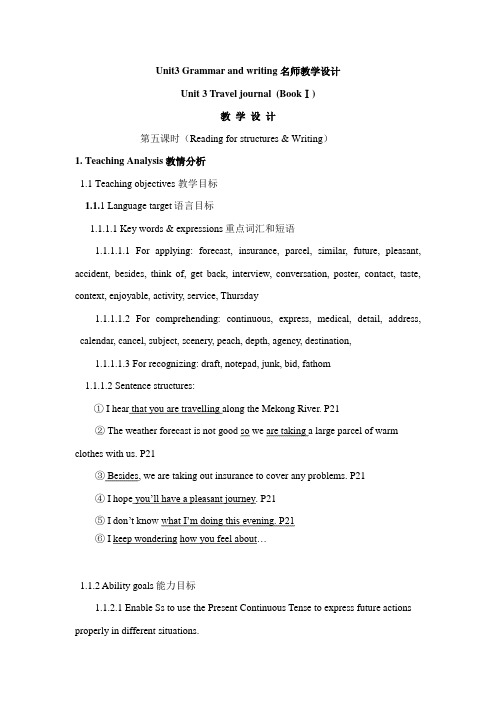
Unit3 Grammar and writing 名师教学设计Unit 3 Travel journal (BookⅠ)教学设计第五课时(Reading for structures & Writing)1. Teaching Analysis 教情分析1.1 Teaching objectives 教学目标1.1.1 Language target语言目标1.1.1.1 Key words & expressions重点词汇和短语1.1.1.1.1 For applying: forecast, insurance, parcel, similar, future, pleasant, accident, besides, think of, get back, interview, conversation, poster, contact, taste, context, enjoyable, activity, service, Thursday1.1.1.1.2 For comprehending: continuous, express, medical, detail, address, calendar, cancel, subject, scenery, peach, depth, agency, destination,1.1.1.1.3 For recognizing: draft, notepad, junk, bid, fathom1.1.1.2 Sentence structures:①I hear that you are travelling along the Mekong River. P21②The weather forecast is not good so we are taking a large parcel of warm clothes with us. P21③ Besides, we are taking out insurance to cover any problems. P21④I hope you’ll have a pleasant journey. P21⑤I don’t know what I’m doing this evening. P21⑥ I keep wondering how you feel about…1.1.2 Ability goals能力目标1.1.2.1 Enable Ss to use the Present Continuous Tense to express future actions properly in different situations.1.1.2.2 Enable Ss to learn how to write an email.1.1.2.3 Get the students to learn how to make a travel poster.1.1.3 Emotion goals情感目标1.1.3.1 Enable Ss to communicate with others well by properly using the Present Continuous Tense in daily life.1.1.3.2 Enable Ss to express themselves well by writing excellent emails and making wonderful posters.1.2 Important & difficult teaching points-教学重难点1.2.1 Important teaching points-教学重点1.2.1.1 How to get Ss to master the usage of the Present Continuous Tense for future actions.1.2.1.2 How to get Ss to learn to write an email and a travel poster.1.2.2 Difficult teaching points-教学难点1.2.2.1 How to use the Present Continuous Tense to express future actions.1.2.2.2 How to write an email well.2. Student analysis学情分析2.1 Fundamental state基本情况学生在初中已经学习了现在进行时,掌握了现在进行时的基本用法。
人教版高中英语必修1Unit3Grammar课件高中英语精品公开课
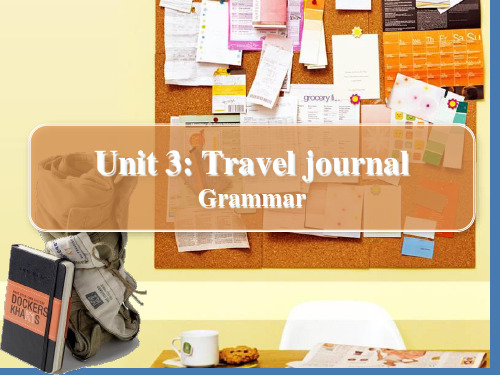
现在进行时的用法
1. 表示说话时正在进行的动作或存在的状态。
We are waiting for you now. 时间状语:now, at this moment…
2.表示现阶段在进行的情况。
Right now it is the summer holiday he farm.
present continuous tense future action
2. A: How are you going to Shanghai? B: By plane.
present continuous tense future action
3. A: When are you arriving in Shanghai? B: Next Monday morning.
She is always thinking about others first. 她总是先想到别人。
现在进行时除了表示正在进行的情况 外,还可以表示????
Look at the following sentences and guess what time they express. 1. A: When are you leaving for Shanghai? B: Next Sunday.
1) come, go, stay, arrive, leave 等趋向动词的现 在进行时经常用于表示将来确切的计划。
I am leaving China in two hours.
我将会在两个小时后离开中国。
2) 表示交通方式、行程安排的动词,例如 fly, walk, ride, drive, take (a bus, a taxi)等的现在 进行时也经常用于表示将来。
外研版高中英语必修1 Module3_Grammar_公开课教学设计

Module3 Grammar 公开课教学设计Module Three Grammar The –ed Form As Attribute& Predicate(课程设计)The –ed Form As Attribute & Predicate教学目标:结合本单元课文原句熟练掌握过去分词作定语。
使学生对非谓语动词的运用打下坚实的基础。
巩固学习一般过去时,使学生能够区分–ed form 作定语和谓语的一般过去时态。
学情分析:高一学生对形容词作定语已有些浅显的认识,在此基础上能够学习掌握过去分词作定语。
但是学生对过去分词作定语的识别、判断是其掌握本节课语法知识的关键。
教学重点:学会识别与运用过去分词作定语的意义和功能。
教学难点:拓展过去分词作定语与现在分词作定语的区别。
如何判断动词在句中作定语而不是作谓语。
即树立非谓语动词的观念。
教学过程:Step1.Lead-in利用学生在上节课学习的阅读内容中对于Ghan train 的了解,引出形容词作定语的例子。
同时启发学生思考能够作定语的其它情况。
以此为学生学习掌握过去分词作定语打下伏笔。
E.g. It is a wonderful /famous /comfortable trainStep2.Presentation细致分析课文原句Trained camels carried food and other supplies.启发学生发现划线的两个–ed form 的区别:1.主语camel后的-ed为过去式在句中作谓语,说明句子是一般过去时。
2.修饰、限制、描述名词camel的–ed form是过去分词,它起形容词作用在句中作定语,属于非谓语动词。
Step3.Example.呈现更多的例句让学生去找出作定语的过去分词和作谓语的过去式。
并强调–ed form 有时是不规则的。
着重讲解过去分词作定语的意义:表示被动或动作已完成。
E.g. We saw abandoned farms which were built more than a hundred years ago. E.g. We ate great meals cooked by experts.学生对比以上两个例句,分析发现分词作定语在句中所在的位置。
外研版高中英语必修一 Module3 Grammar教案-新版

A. development B. developingC. developed D. develop
5. I have collected the money ____.
A. needing B. needC. to need D. needed
a used car一辆旧车
a car used一辆用过的车
2)过去分词短语作定语通常后置,其作用相当于定语从句。如:
the color TV set produced last year =the color TV setthat were producedlast year
3)要注意过去分词做定语时动作发生的时间:
Learn & do exercise
Learn & do exercise
10’
24’
27’
1’
板书
Unit 3 My first ride on a train
The 3rd Period
Grammar
-ed分词既可以作前置定语,也可以作后置定语。
1)单个的过去分词作定语
(1)作前置定语:这时过去分词的形容词意义强于动词意义。
(2)表示与句中谓语动词相应的经常性的动作。如:
He was then a professor respected (that was respected) by all the teachers and students of the college.
当时他是一个受这所大学里全体师生尊敬的教授。
2. Practice
学生送的礼物
人教课标版必修一英语Unit3 Grammar 课程教学设计(一)
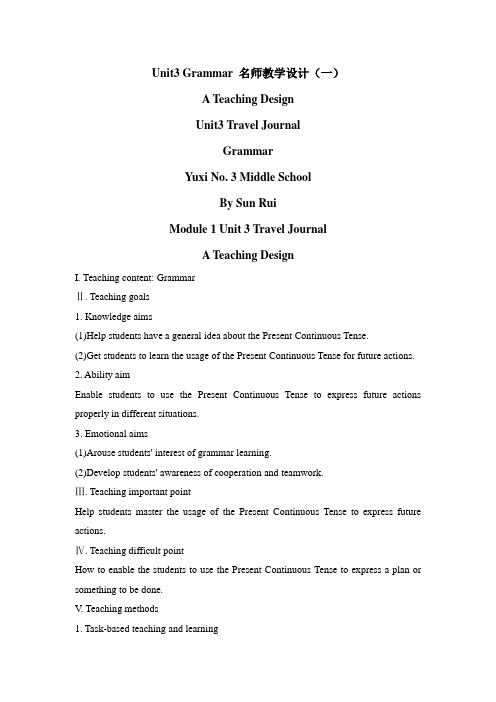
Unit3 Grammar 名师教学设计(一)A Teaching DesignUnit3 Travel JournalGrammarYuxi No. 3 Middle SchoolBy Sun RuiModule 1 Unit 3 Travel JournalA Teaching DesignI. Teaching content: GrammarⅡ. Teaching goals1. Knowledge aims(1)Help students have a general idea about the Present Continuous Tense.(2)Get students to learn the usage of the Present Continuous Tense for future actions.2. Ability aimEnable students to use the Present Continuous Tense to express future actions properly in different situations.3. Emotional aims(1)Arouse students' interest of grammar learning.(2)Develop students' awareness of cooperation and teamwork.Ⅲ. Teaching important pointHelp students master the usage of the Present Continuous Tense to express future actions.Ⅳ. Teaching difficult pointHow to enable the students to use the Present Continuous Tense to express a plan or something to be done.V. Teaching methods1. Task-based teaching and learning2. Cooperative learning3. DiscussionVI. Teaching aids:1. The multi-media2. The blackboardVII. Teaching ProceduresStep 1 GreetingGreet the students as usual.Step 2Lead-in1. Show the pictures of some activities on the screen and ask the students to answer the question “What is she/he doing?”【设计意图】通过观看与各种活动有关的图片,说出图片中的人物正在做什么,调动学生的热情,激起学生的学习兴趣,为本节课创设良好的开端。
人教课标版必修1英语Unit5 Grammar 公开课教学设计
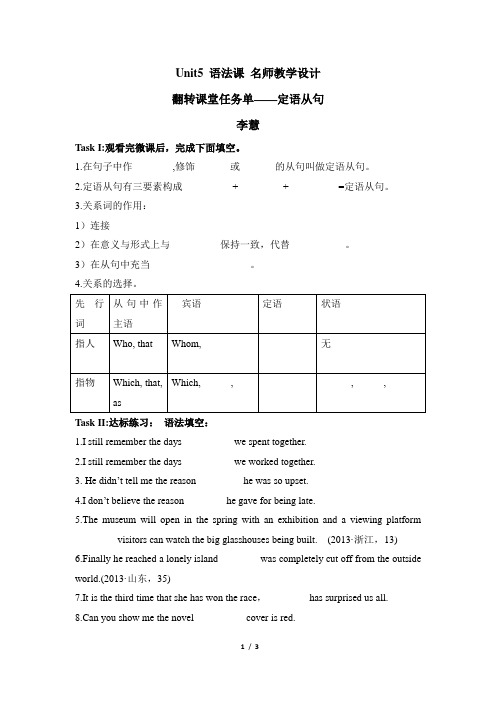
Unit5 语法课名师教学设计翻转课堂任务单——定语从句李慧Task I:观看完微课后,完成下面填空。
1.在句子中作________,修饰_______或_______的从句叫做定语从句。
2.定语从句有三要素构成__________+_________+__________=定语从句。
3.关系词的作用:1)连接__________2)在意义与形式上与__________保持一致,代替___________。
3)在从句中充当____________________。
4.关系的选择。
Task II:达标练习:语法填空:1.I still remember the days__________ we spent together.2.I still remember the days__________ we worked together.3. He didn’t tell me the reason_________ he was so upset.4.I don’t believe the reason________ he gave for being late.5.The museum will open in the spring with an exhibition and a viewing platform ________ visitors can watch the big glasshouses being built. (2013·浙江,13)6.Finally he reached a lonely island________ was completely cut off from the outside world.(2013·山东,35)7.It is the third time that she has won the race,________ has surprised us all.8.Can you show me the novel __________cover is red.改错:1.The prize will go to the writer who story shows the most imagination.2.The day will come which the people all over the world will win liberation.3.I, who is your good friend, will try my best to help you.4.Do you know the man whom our teacher is talking with him over there?5.The radio which I bought it last week has gone wrong.6.The reason which he didn’t go to school is that he was ill.Task III:想一想1.观察下面句子,总结关系词that与which的区别1)Do you have anything that you want to say for yourself?2) Everything that you said is true.由1,2句总结出,当先行词是不定代词_______________________________ 时,关系词只能用that..3) This is the very book that I’m looking for.4) this is the only coat that I have.由3,4句总结出,当先行词被__________________________________修饰时,关系词只用that.5) This is the most attractive match that I have watched.6) This is the last lesson that we have this term.由5,6句总结出,当先行词被_______________________________修饰时,关系词只用that.7) He hasn’t sent us the workers and equipment that we need.由7句总结出,当先行词___________________________,关系词用that. 介词+关系代词的结构,介词如何选择?1)介词由从句中名词,动词,形容词决定。
高中英语人教版高一必修1教案:_unit_3_travel_journal_grammar_教案3
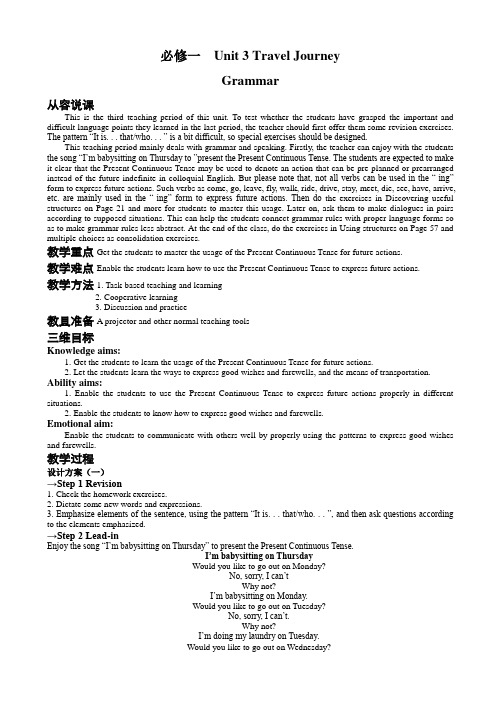
必修一Unit 3 Travel JourneyGrammar从容说课This is the third teaching period of this unit. To test whether the students have grasped the important and difficult language points they learned in the last period, the teacher should first offer them some revision exercises. The pattern “It is. . . that/who. . . ” is a bit difficult, so special exercises should be designed.This teaching period mainly deals with grammar and speaking. Firstly, the teacher can enjoy with the students the song “I’m babysitting on Thursday to ”present the Present Continuous Tense. The students are expected to make it clear that the Present Continuous Tense may be used to denote an action that can be pre-planned or prearranged instead of the future indefinite in colloquial English. But please note that, not all verbs can be used in the “-ing” form to express future actions. Such verbs as come, go, leave, fly, walk, ride, drive, stay, meet, die, see, have, arrive, etc. are mainly used in the “-ing” form to express future actions. Then do the exercises in Discovering useful structures on Page 21 and more for students to master this usage. Later on, ask them to make dialogues in pairs according to supposed situations. This can help the students connect grammar rules with proper language forms so as to make grammar rules less abstract. At the end of the class, do the exercises in Using structures on Page 57 and multiple choices as consolidation exercises.教学重点Get the students to master the usage of the Present Continuous Tense for future actions.教学难点Enable the students learn how to use the Present Continuous Tense to express future actions.教学方法1. Task-based teaching and learning2. Cooperative learning3. Discussion and practice教具准备A projector and other normal teaching tools三维目标Knowledge aims:1. Get the students to learn the usage of the Present Continuous Tense for future actions.2. Let the students learn the ways to express good wishes and farewells, and the means of transportation. Ability aims:1. Enable the students to use the Present Continuous Tense to express future actions properly in different situations.2. Enable the students to know how to express good wishes and farewells.Emotional aim:Enable the students to communicate with others well by properly using the patterns to express good wishes and farewells.教学过程设计方案(一)→Step 1 Revision1. Check the homework exercises.2. Dictate some new words and expressions.3. Emphasize elements of the sentence, using the pattern “It is. . . that/who. . . ”, and then ask questions according to the elements emphasized.→Step 2 Lead-inEnjoy the song “I’m babysitting on Thursday” to present the Present Continuous Tense.I’m babysitting on ThursdayWould you like to go out on Monday?No, sorry, I can’tWhy not?I’m babysitting on Monday.Would you like to go out on Tuesday?No, sorry, I can’t.Why not?I’m doing my laundry on Tuesday.Would you like to go out on Wednesday?No, sorry, I can’t.Why not?I’m working overtime on Wednesday.Would you like to go out on Thursday?No, sorry, I can’t.Why not?I’m working out on Thursday.Would you like to go out on Friday?No, sorry, I can’t.Why not?I’m visiting relatives on Friday.Would you like to go out on the weekend?Well. . . maybe!Ask the students to answer: What is she doing on Monday/Tuesday/. . . ?→Step 3 SummaryShow the following on the screen.The Present Continuous Tense for future actionsThe Present Continuous Tense can be used to express a plan or an arrangement.现在进行时可用来表示一个在最近按计划或打算要进行的动作;表示将来意义的现在进行时由句中表示将来时间的词语或上下文表明。
高中英语 Unit1 第3学时 Grammar学案 新人教版必修1

高中英语 Unit1 第3学时 Grammar学案新人教版必修1Grammar学案新人教版必修1直接引语和间接引语Task1、请比较下列几组句子,找出它们的变化规律。
1)John said, "Im going to London with my father、"John said that he was going to London with his father、2) She said, "Do you often come here to read newspapers?"She asked me if (或whether)I often went there to read newspapers、3)She asked me , "You have seen the film, havent you?"She asked me whether(或if )I had seen the film、4)I asked him, "Will you stay at home or go to a film tonight?"I asked him whether he would stay at home or goto a film that night、5)He asked , "Where do you live?"He asked me where I lived、6)He said, "Lets go to the theatre、"He suggested(our )going to the theatre、或He suggested that we(should) go to the theatre、7)"Would you mind opening the window?" he asked、He asked me to open the window、8)"Why dont you take a walk after supper?" he asked 、He advised me to take a walk after supper、9)"Shall we listen to the music?" he asked、He suggested listening to the music、10)She said, "What a lovely day it is !"She said what a lovely day it was 、或She said that it was a lovely day、小结:由直接引语变为间接引语,分以下情况:1、直接引语是陈述句时,转换成间接引语,需用________引导; 从句中的______________________要做相应的改变、2、直接引语是一般疑问句或反问句时,转换成间接引语,需用________引导, 同时将疑问句变成_____________、直接引语是选择疑问句,要变成间接引语时,需_____________________、3、直接引语是特殊疑问句时,转换成间接引语,引导词_________________、从句要变成________________________________、4、直接引语是感叹句时,转换成间接引语,需:_________________________________________________________ _____________ Task2、通过观察下列几组句子,找出它们的时态变化特点。
人教版高中英语必修一Unit5 Grammar 教学设计
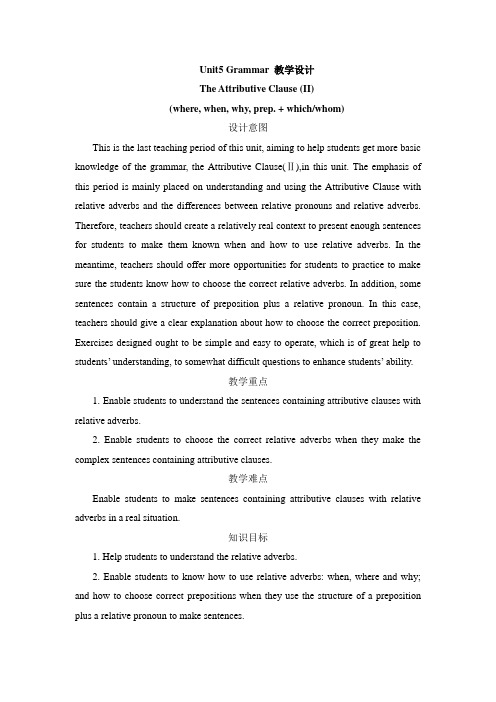
Unit5 Grammar 教学设计The Attributive Clause (II)(where, when, why, prep. + which/whom)设计意图This is the last teaching period of this unit, aiming to help students get more basic knowledge of the grammar, the Attributive Clause(Ⅱ),in this unit. The emphasis of this period is mainly placed on understanding and using the Attributive Clause with relative adverbs and the differences between relative pronouns and relative adverbs. Therefore, teachers should create a relatively real context to present enough sentences for students to make them known when and how to use relative adverbs. In the meantime, teachers should offer more opportunities for students to practice to make sure the students know how to choose the correct relative adverbs. In addition, some sentences contain a structure of preposition plus a relative pronoun. In this case, teachers should give a clear explanation about how to choose the correct preposition. Exercises designed ought to be simple and easy to operate, which is of great help to student s’ understanding, to somewhat difficult questions to enhance students’ ability.教学重点1. Enable students to understand the sentences containing attributive clauses with relative adverbs.2. Enable students to choose the correct relative adverbs when they make the complex sentences containing attributive clauses.教学难点Enable students to make sentences containing attributive clauses with relative adverbs in a real situation.知识目标1. Help students to understand the relative adverbs.2. Enable students to know how to use relative adverbs: when, where and why; and how to choose correct prepositions when they use the structure of a preposition plus a relative pronoun to make sentences.呈现新知Lead-inT: Hello, everybody! Today we are going to learn something more about the Attributive Clause.First, look at the screen and make the sentences according to the pictures. (The teacher writes down the sentences on the blackboard.)1. It is our classroom.2. We study in our classroom.3. Today is March 12th.4. People get together to plant trees.5. Jack was absent.6. He gave me the reason.T: Now look at the blackboard. We can combine the sentences.Sentences 1 and 2: It is our classroom where we study.Sentences 3 and 4: Today is March 12th when people get together to plant trees.Sentences 5 and 6: He gave me the reason why Jack was absent.感受新知Ⅰ. Read the sentences aloud. This is a complex sentence. Analyze the sentences.1. It is our classroom (where) we study.↓ ↓ ↓↓ ↓ attributive clause(定语从句)antecedent relative adverb(act as the adverbial in the attributive clause)(先行词)(关系副词)2. Today is March 12th (when) people get together to plant trees.↓ ↓antecedent relative adverb (act as the adverbial in the attributive clause)3. He gave me the reason (why) Jack was absent.。
新人教版高一英语必修一第一册 Unit 3 教案
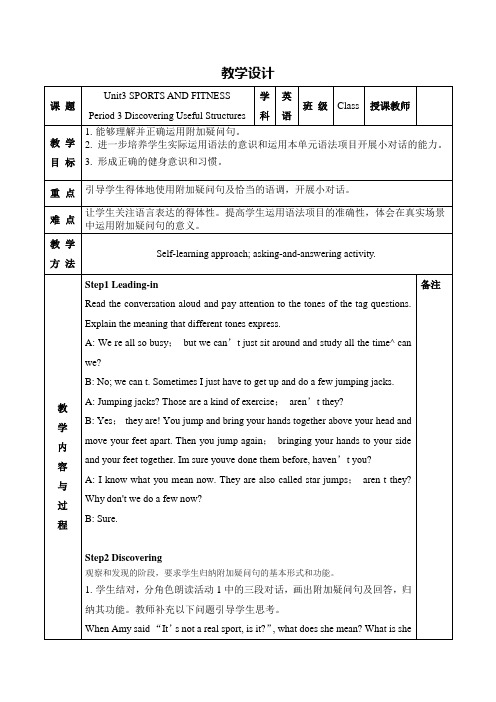
引导学生得体地使用附加疑问句及恰当的语调,开展小对话。
难点
让学生关注语言表达的得体性。提高学生运用语法项目的准确性,体会在真实场景中运用附加疑问句的意义。
教学方法
Self-learning approach; asking-and-answering activity.
教
学
内
容
与
过
程
Step1 Leading-in
When is your birthday?
What do you have for breakfast?
What is your favourite sport?
What sports events have you been to?
Can you ski?
3. Ask students to add a few more questions.
4. As a warm-up activity, have students ask each other the questions in pairs,
swapping pairs a few times.
5. Model the activity with a student first.Tell students not to write down any of the answers, and continue with your class on tag questions.
1. So the other girl won, did she?(根据语境,可以表示兴趣)
2. Oh, you’ve made another mistake, have you?(根据语境,可以表示愤怒)
高中英语必修1Unit3Grammar教学设计
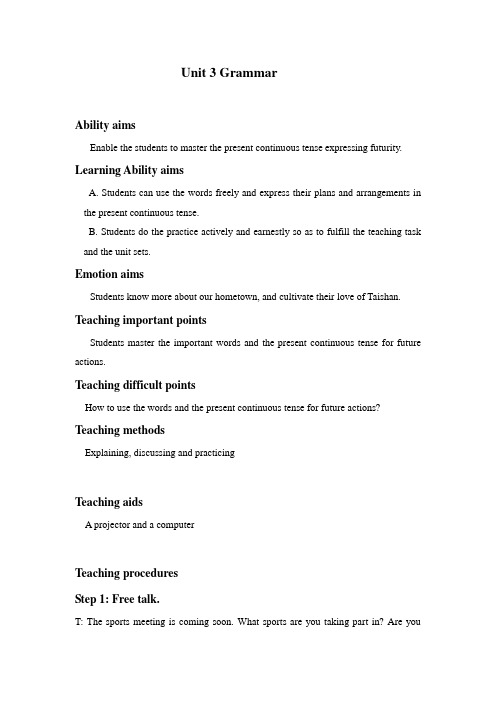
Unit 3 GrammarAbility aimsEnable the students to master the present continuous tense expressing futurity. Learning Ability aimsA. Students can use the words freely and express their plans and arrangements in the present continuous tense.B. Students do the practice actively and earnestly so as to fulfill the teaching task and the unit sets.Emotion aimsStudents know more about our hometown, and cultivate their love of Taishan. Teaching important pointsStudents master the important words and the present continuous tense for future actions.Teaching difficult pointsHow to use the words and the present continuous tense for future actions? Teaching methodsExplaining, discussing and practicingTeaching aidsA projector and a computerTeaching proceduresStep 1: Free talk.T: The sports meeting is coming soon. What sports are you taking part in? Are youpreparing for it? What are you doing these days?Step 2: Review and leading inT: look at these 4 sentences on the screen. They are all in present continuous tense. But they express different meanings. Think them over in 30 seconds, and then explain.Next show the sentence, The Browns are leaving for China tomorrow, and lead to the key point of this class——presents continuous expresses future actions.Step 3: Discovering useful structurePay attention to the verbs that use presents continuous expresses future actions. Then make a brief summary.A. leave, go, arrive, stay, come, return, start, have, play, do, take, get, travel, reach, meet, start, begin等表示去向、“移动”概念的动词, 表述已计划好的动作,常用现在进行时表将来。
人教版高中英语必修一Unit3 语言点教学设计
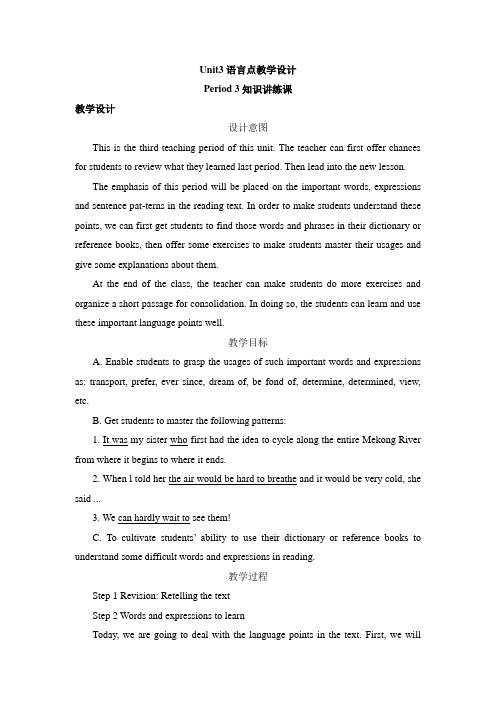
Unit3语言点教学设计Period 3知识讲练课教学设计设计意图This is the third teaching period of this unit. The teacher can first offer chances for students to review what they learned last period. Then lead into the new lesson.The emphasis of this period will be placed on the important words, expressions and sentence pat-terns in the reading text. In order to make students understand these points, we can first get students to find those words and phrases in their dictionary or reference books, then offer some exercises to make students master their usages and give some explanations about them.At the end of the class, the teacher can make students do more exercises and organize a short passage for consolidation. In doing so, the students can learn and use these important language points well.教学目标A. Enable students to grasp the usages of such important words and expressions as: transport, prefer, ever since, dream of, be fond of, determine, determined, view, etc.B. Get students to master the following patterns:1. It was my sister who first had the idea to cycle along the entire Mekong River from where it begins to where it ends.2. When l told her the air would be hard to breathe and it would be very cold, she said ...3. We can hardly wait to see them!C. To cultivate students’ ability to use their dictionary or reference books to understand some difficult words and expressions in reading.教学过程Step 1 Revision: Retelling the textStep 2 Words and expressions to learnToday, we are going to deal with the language points in the text. First, we willselect several important words and expressions from the text. Try to use your dictionary or reference books to understand their meanings and find more usages of them. Then we will do some exercises.1. Which kind of transport do you prefer to use, bus or train?你比较喜欢哪种交通工具,公共汽车还是火车?【观察思考】l) The products can’t be transported because of the heavy sno w. 那些产品因大雪而无法运送。
人教版英语必修一Unit 3(Grammar)表格教案
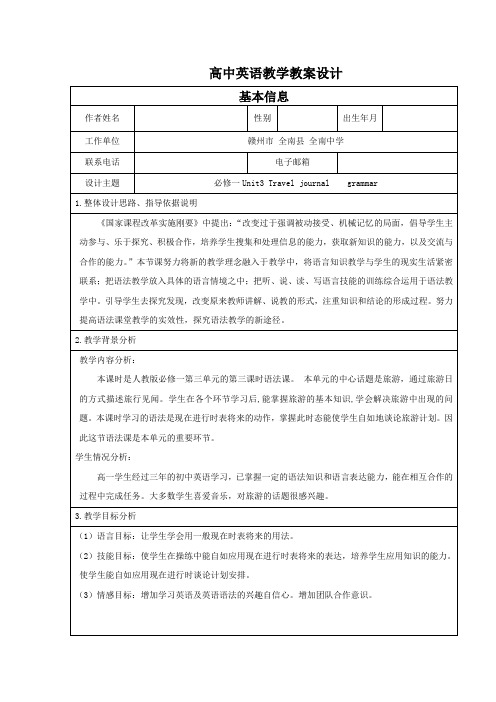
高中英语教学教案设计基本信息作者姓名性别出生年月工作单位赣州市全南县全南中学联系电话电子邮箱设计主题必修一Unit3 Travel journal grammar1.整体设计思路、指导依据说明《国家课程改革实施刚要》中提出:“改变过于强调被动接受、机械记忆的局面,倡导学生主动参与、乐于探究、积极合作,培养学生搜集和处理信息的能力,获取新知识的能力,以及交流与合作的能力。
”本节课努力将新的教学理念融入于教学中,将语言知识教学与学生的现实生活紧密联系;把语法教学放入具体的语言情境之中;把听、说、读、写语言技能的训练综合运用于语法教学中。
引导学生去探究发现,改变原来教师讲解、说教的形式,注重知识和结论的形成过程。
努力提高语法课堂教学的实效性,探究语法教学的新途径。
2.教学背景分析教学内容分析:本课时是人教版必修一第三单元的第三课时语法课。
本单元的中心话题是旅游,通过旅游日的方式描述旅行见闻。
学生在各个环节学习后,能掌握旅游的基本知识,学会解决旅游中出现的问题。
本课时学习的语法是现在进行时表将来的动作,掌握此时态能使学生自如地谈论旅游计划。
因此这节语法课是本单元的重要环节。
学生情况分析:高一学生经过三年的初中英语学习,已掌握一定的语法知识和语言表达能力,能在相互合作的过程中完成任务。
大多数学生喜爱音乐,对旅游的话题很感兴趣。
3.教学目标分析(1)语言目标:让学生学会用一般现在时表将来的用法。
(2)技能目标:使学生在操练中能自如应用现在进行时表将来的表达,培养学生应用知识的能力。
使学生能自如应用现在进行时谈论计划安排。
(3)情感目标:增加学习英语及英语语法的兴趣自信心。
增加团队合作意识。
4.教学重点、难点分析教学重点:掌握现在进行时表示将来的用法。
能用现在进行时谈论旅游计划。
教学难点:进一步巩固现在进行时表示将来的用法。
提高学生处理信息、探索发现和解决问题的能力,以及学生口语运用能力和合作能力。
5.过程设计(中文为主 + 英语)步骤1:导入1.播放英语歌曲“I’m babysitting on Thursday”让学生欣赏。
人教版高中英语必修一Unit3 Grammar 学案

Unit3 Grammar 学案Unit 3 Travel journalPeriod 4语法专题课Express the future actions using v. -ing感受新知Ⅰ. Read and pay attention to the verbs.A travel planThe Browns are going to North China by train next week. They are staying in Beijing for a week. They are leaving for Xi’an by air.Ⅱ. More sentences and verbs. Translate the sentences using the verbs.1. 我这个星期五动身去北京。
(leave)2. 我的朋友今晚过来。
(come)3. 下周五我们乘飞机去上海。
(fly)4. 下课后我们打算在操场踢足球。
(play)Ⅲ. Conclusion of the rules1. When we refer to an action that will happen as planned, we can use v. -ing.2. Only special verbs could be used here, usually the verbs indicating an action or a change of a location, e. g. :, , , , , arrive, stay, etc.巩固运用Ⅰ. Write down your dialogue after listening to the following one.A:What are you doing tomorrow?B:I’m seeing my sister off at the airport in the morning. She’s leaving for New York and staying there for three days.A:Are you doing anything special tomorrow afternoon, then?B:No. I’m staying at home.A:But I’m playing tennis with Tom. I’m meeting him at 3:30. Will you join us?B:Great!Ⅱ. Multiple choice.1. Ladies and gentlemen, please fasten your seatbelts. The plane in a minute.A. takes offB. is taking offC. has taken offD. took off2. —Are you still busy?—Yes, I my work, and it won’t take long.A. just finishB. am just finishingC. have just finishedD. am just going to finish3. —Will you tell us something about the weather in Canada?—I to that.A. comeB. am comingC. am goingD. came4. The mid-term exam , and everyone is trying hard to study.A. was comingB. cameC. has comeD. is coming拓展Ⅰ. More structures refer to an action to happen in the future.1. I will/shall write you a letter.2. We’re going to have many classes next week.3. I was about to lock the door when the telephone rang.4. If you are late, you are to stand outside the door.5. The plane to Beijing takes off at 7:35 tomorrow.Conclusion:1)Sentence 1, 2:common forms of future tense.2)be going to do 可表有迹象要发生的事3)Sentence 3:be about to do. . . when 意思是。
外研版高中英语必修1 Module3_Grammar_名师教学设计
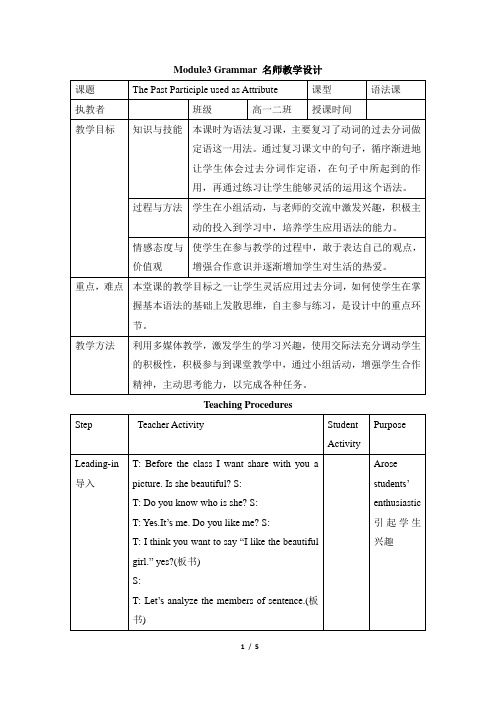
通过描述多媒体呈现的图片,让学生说出对应的v-ed,再将句子转换成v-ed做定语的形式。从而先让学生对语法有一个很形象的感知。
T:TodaywewillrevisetheV-edusedasattribute.(板书写标题)
Now,lookatthispicturetellme,what’sthesituationinthepicture?S:
Payattentiontotheunderlinenounsismodifiedbyv-ed.PastParticiplecanalsobeusedasadjective.
通过展出与生活相关的图片,激发学生兴趣,引出过去分词作定语。既复习了形容词作定语,又引出了本节课复习的语法(过去分词作定语)
Arosestudents’enthusiastic引起学生兴趣
教学方法
利用多媒体教学,激发学生的学习兴趣,使用交际法充分调动学生的积极性,积极参与到课堂教学中,通过小组活动,增强学生合作精神,主动思考能力,以完成各种任务。
TeachingProcedures
Step
TeacherActivity
StudentActivity
Purpose
Leading-in导入
S:
T:Yesandwhichoneisthepredicate(Verb)S:
T:NowIwillaskyouthequestionsraisebytheaudiencehappenbeforeorafterthespeaker.
S:Before.
Tsowesay过去分词
Step4总结
T:sowecansummarizeinshort:
T:BeforetheclassIwantsharewithyouapicture.Isshebeautiful?S:
高中英语人教版必修1教案Unit3TravelJournalGrammar教案5
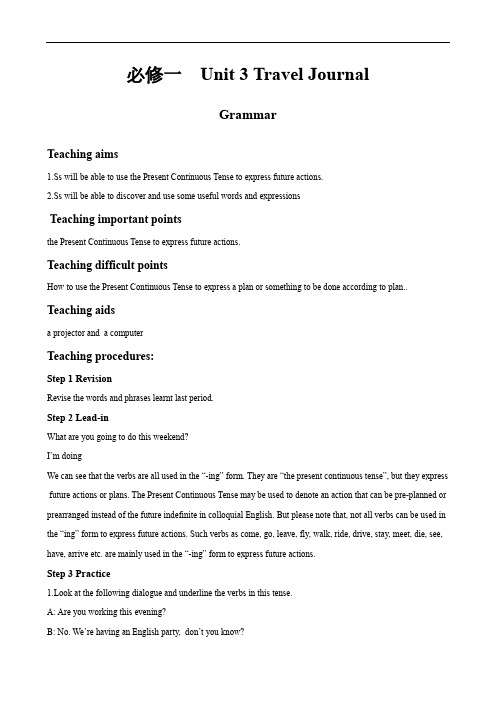
必修一Unit 3 Travel JournalGrammarTeaching aims1.Ss will be able to use the Present Continuous Tense to express future actions.2.Ss will be able to discover and use some useful words and expressionsTeaching important pointsthe Present Continuous Tense to express future actions.Teaching difficult pointsHow to use the Present Continuous Tense to express a plan or something to be done according to plan.. Teaching aidsa projector and a computerTeaching procedures:Step 1 RevisionRevise the words and phrases learnt last period.Step 2 Lead-inWhat are you going to do this weekend?I’m doingWe can see that the verbs are all used in the “-ing” form. They are “the present continuous tense”, but they express future actions or plans. The Present Continuous Tense may be used to denote an action that can be pre-planned or prearranged instead of the future indefinite in colloquial English. But please note that, not all verbs can be used in the “ing” form to express future actions. Such verbs as come, go, leave, fly, walk, ride, drive, stay, meet, die, see, have, arrive etc. are mainly used in the “-ing” form to express future actions.Step 3 Practice1.Look at the following dialogue and underline the verbs in this tense.A: Are you working this evening?B: No. We’re having an English party, don’t you know?A: Yes, I do. And we’re giving some performance at the party. What are you going to do? B: I’m singing song wit h my classmates. 2. Doing exercises No. 2 and 3 on page 21Now turn to page 21 and do exercise 2. In the dialogue a newspaper reporter is interviewing Wang Wei about her plans for the trip along the Mekong River. However, they are not sure about some of the verb tenses. Can you help them complete their conversation?Let’s continue to do exercise 3. Do you have any plans for the future yourselves? If you have any, please use the P resent Continuous Tense to express your future actions. Give as much information as you can.Step4 Dialogue1. First show an example: Where you going on holiday?A: Yanzi, where you going on holiday? B: I’ m going to Laos. A: When are you leaving? B: Next Sund ay. A: How are you going to Laos? B: I’m taking a plane. A: How long are you staying there? B: About two weeks. A: Great. Have a good trip. B: Thanks. Farewells:Have a good trip/ journey; Have a good day/ time; Enjoy yourself; Best wishes; Have fun; Good luck; Take care!Step5 HOMEWORKDo exercises on Page 56, 57。
- 1、下载文档前请自行甄别文档内容的完整性,平台不提供额外的编辑、内容补充、找答案等附加服务。
- 2、"仅部分预览"的文档,不可在线预览部分如存在完整性等问题,可反馈申请退款(可完整预览的文档不适用该条件!)。
- 3、如文档侵犯您的权益,请联系客服反馈,我们会尽快为您处理(人工客服工作时间:9:00-18:30)。
(5) be +V-ing形式: 表示按计划或 安排要发生的事, 含义是 “预定要……” 这一结构常用趋向动词 go, arrive, come, leave, start, stay, return和play, do, have, work, wear, spend, see, meet等。
--- When are you going off for your holiday? 你什么时候动身去度假?
Grammar
用现在进行时表示将来
当句子涉及确切的计划、明确的意图 和为将来安排好的活动时, 现在进行 时可用于表示将来。
1. 现在进行时表将来使用的动词常为 趋向性动词和表示位置转移的动词, 常用的有: arrive, come, do, get, go, have, leave, meet, play, return, see, spend, start, stay, wear, work 等。如: How are you going, by boat or by train? I’m meeting you after class.
ห้องสมุดไป่ตู้
(3)be to+动词原形: 表示按计划要发生 的事或征求对方的意见。如: Are we to go on with this work? (4)be about to+动词原形, 表示即将发生 的动作, 不与表示将来的时间状语连用。 I was about to go swimming when my guide shouted at me and told me not to do so. 我正要去游泳, 这时向导大声叫我不要去。
3. 表将来的现在进行时有时含有 “决心”的意思, 多用在否定结构 中。如:
I’m not waiting any longer.
4. 现在进行时也可在时间、条件或原 因状语从句中表示将来。如: When you are passing my house, please drop in. If they are not doing it, what should I do? Because the bride is coming, all the people are pleased.
② 在状语从句中用一般现在时代替 将来时。
If you do that again, I’ll hit you. ③ 用在I bet 和I hope后面, 常用一般
2. The Browns _a_re__g_o_in__g (go) to the North China by train next week. They _a_re__s_ta_y_i_n_g_ (stay) in Beijing for a week. They _a_re__g_o_in_g_ (go) to Xi’an. They _a_re__g_e_tt_i_n_g_ (get) there by air.
2. 现在进行时常表最近或较近的将来, 句子里常有一个表示未来的时间状语。 如: They’re leaving for Hong Kong this afternoon. What are you doing next Sunday? I’m not going out for dinner this evening.
--- My plane is taking off at 9:20, so I must be at the airport by 8:30. 我乘坐的飞机将于9:20分起飞, 所以我必须在8:30之前赶到机场。
(6)一般现在时表示将来时 ① 按规定预计要发生的未来动作, 仅限
于动词come, go, leave, move, start, return, arrive, begin, stay等动词。如: The plane takes off at 10:10. That is, it’s leaving in ten minutes.
5. 现在进行时表将来与一般现在时 表将来的区别在于: 用现在进行时表 示将来, 其计划性较强, 并往往暗示 一种意图; 而一般现在时表示将来, 则其客观性 较强, 即通常被视为客观事实, 多指 按时刻表或规定要发生的情况。
如果主语是train, concert, programme 等表示事物的名词, 动词通常用一般 现在时表将来而不用进行时。如: What time does the train to Shanghai leave?
注意!
另外, 表示将来的动作或状态还可用以 下几种形式: (1) will / shall+动词原形
I shall be seventeen years old next month. (2) be going to+动词原形: 表示即将发生的
或最近打算进行的事。 We are going to have a meeting today.
3. Some friends _a_r_e_c_o_m_i_n_g_ (come) to Anne’s birthday party this evening. Anne’s mother _i_s (be) busy _g_et_t_in_g_ (get) ready for the birthday dinner. Anne _is__h_e_lp_i_n_g_ (help) her mother now.
练一练
1. Betty _is_l_e_a_v_in_g_ (leave) for Guangzhou by plane at 3:00 this afternoon. Her brother Bob _i_s_s_e_ei_n_g_ (see) her off. It’s half past one now. They _a_r_e_w_a_i_t_in_g_ (wait) for a taxi outside the school gate.
